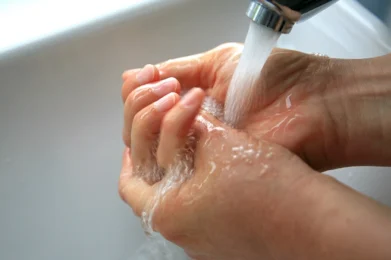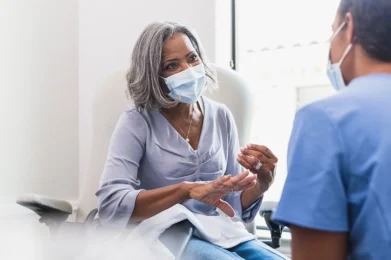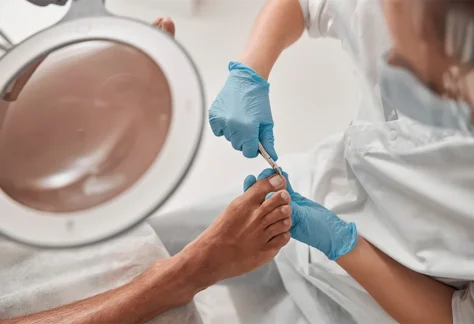In This Article:
- Common knee injuries include tears to the patellar tendon or ACL. They also include overuse problems, like patellar tendonitis and runner’s knee.
- Common shoulder problems include SLAP tears, shoulder instability and rotator cuff injuries.
- If you experience popping, tearing, swelling, decreased range of motion or other pain in your shoulders or knees, talk to your doctor.
Why is it that the knee and shoulder are considered some of the most frequently injured areas when being active? For one, we bear weight on our knees, especially during physical activity. With the added element of quick changes in direction, the knee is prone to meniscus and ligament tears. Repetitive endurance sports risk overuse type issues. Likewise, the shoulder is one of the most mobile joints in the body, trading stability for motion. Injuries can easily create instability problems. The rotator cuff stabilizes the shoulder, particular with overhead sports, coupled with age related changes increase risk.
Let’s discuss some common injuries to the knee and shoulder, their symptoms, and how to prevent them from happening.
Tears to the knee
Tears are one of the more frequent issues seen in the knee, specifically in the menisci, tendons and ligaments.
If you’re unfamiliar, the meniscus is the C-shaped fibrocartilage cushioning the gap between the thighbone and the shinbone, which can tear suddenly when twisting and turning. Next, the patellar tendon, connecting the kneecap to shin bone, is one of the main tendons prone to injury caused by falling or being hit. The ACL, one of the four main ligaments of the knee, is a commonly injured changing direction, landing improperly, or from direct impact in contact sports.
Symptoms for tears in these three main areas include:
- Pain, swelling, bruising or tightness in the affected area
- Looseness or inability to put weight on the knee
- Difficulty walking or extending the knee
- Popping or tearing sounds during the event of the injury
Overuse problems
Injuries to the knee caused by overuse appear gradually from repetitive motion. Tendons in the knee are particularly susceptible to overuse issues, and may even rupture if not treated properly. Patellar tendinitis is an example of overuse, and can lead to inflammation and weakening of the tendon. Patellofemoral pain syndrome, or runner’s knee, is another common overuse injury characterized by tenderness and pain behind or around the kneecap.
Common shoulder injuries
The shoulder is the most mobile joint in the body, but it is also at high risk for sports-related injuries, such as tears, instability, and overuse.
Slap tear
A SLAP tear refers to a tear in the top portion of the labrum, the ring of fibrocartilage deepening the shoulder socket, and is generally caused by repetitive injury. This tear is common when playing baseball, volleyball and tennis, as well as swimming.
Shoulder instability
Shoulder instability is common among contact sport athletes, and happens when the ligaments, tendons and muscles surrounding your shoulder joint are no longer secure, which can lead to dislocation of the humeral head, which is part of the ball-and-socket joint of the shoulder.
Injuries to the rotator cuff
The rotator cuff is made up of tendons whose job is to keep the humeral head placed in the socket. For those participating in repetitive and overhead shoulder motions commonly found in swimming and tennis, you may be more at risk for an injury to your rotator cuff.
Common symptoms of these shoulder injuries might include:
- Decreased range in motion
- Feeling of instability
- Weakness in the shoulder
- Pain
Overall tips for preventing further injury
A large part of sports medicine is the practice of preventative methods and day to day recovery. In general, it’s advised to stay consistently active, rather than doing so in short bursts. If you’re running, divide runs up into smaller, more manageable segments and look to do lower impact cross training. The treadmill, elliptical, stairs, and stationary bike are all helpful alternatives.
For more minor aches and pains, the RICE method is recommended for recovery purposes. RICE stands for rest, ice, compression and elevation. As a rule of thumb, heat is better for chronic pain, while icing (in increments of ten minutes) is best for acute injuries.
If you’re just getting back into action, try building up muscle with these lower impact activities before transitioning to more strenuous work. Both stretching and active warm ups are healthy ways to prevent injury, so do what feels best to you.
When to seek further care
Sports medicine continues to be helpful both in the day to day management of aches and pains, as well as in the event of surgery and aftercare. Remember to schedule an appointment as soon as possible in the event of an injury that prevents you from walking and moving normally, as an X-ray or other further operations may be advised. If the injury is less severe, it’s still good practice to see the doctor soon in order to get a diagnosis, start recovery, and get you back on the right path sooner.
Want to learn more about sports medicine and how it can help you stay active? Speak with a doctor at Valleywise Health to learn more about our sports medicine services, and the new clinic opening up in Peoria in February, 2021. Book your appointment at ValleywiseHealth.org or call 1 (833) VLLYWSE.
Sources:
- https://www.medicalnewstoday.com/articles/319324
- https://www.verywellhealth.com/treatment-of-a-patellar-tendon-tear-2549591
- https://www.webmd.com/fitness-exercise/guide/knee-ligament-injuries#1
- https://www.mayoclinic.org/diseases-conditions/patellar-tendinitis/symptoms-causes/syc-20376113#:~:text=Patellar%20tendinitis%20is%20a%20common,and%20weakening%20of%20the%20tendon.
- https://www.runnersworld.com/health-injuries/a20823869/knee-injuries-from-running/
- https://www.sports-health.com/blog/3-common-shoulder-sports-injuries
- https://www.medicalnewstoday.com/articles/321469#benefits








